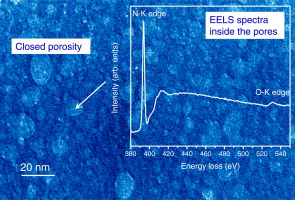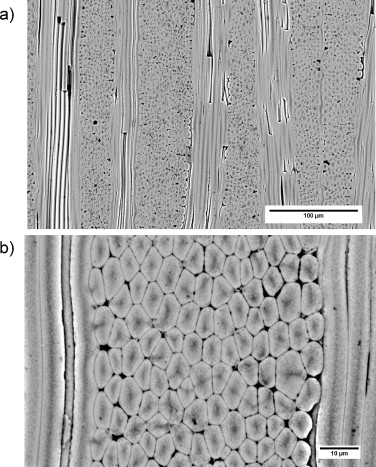Artículos SCI
2012
2012
Materiales Nanoestructurados y Microestructura
Magnetron sputtered a-SiO xN y thin films: A closed porous nanostructure with controlled optical and mechanical properties
Godinho, V; Rojas, TC; Fernandez, AMicroporous and Mesoporous Materials, 149 (2012) 142-146
Show abstract ▽

Amorphous silicon oxynitride coatings with similar composition and different closed porosity were prepared by magnetron sputtering. Pores size, shape and distribution were evaluated by scanning electron microscopy and transmission electron microscopy. Raman and EELS analysis proved that the pores are filled with molecular nitrogen trapped during deposition. The mechanical properties evaluated by nanoindentation shows that the presence of closed nano-porosity does not compromise the mechanical integrity of these coatings. The introduction of closed porosity is shown as a good strategy for obtaining lower dielectric constant silicon oxynitride coatings with similar composition while keeping the good mechanical properties (∼13 GPa) characteristic of this type of coatings. The presence of close porosity gives also a good stability of coatings properties as compared to open porosity microstructures where gas phase in contact with the coatings can affect coatings properties.
Febrero, 2012 | DOI: 10.1016/j.micromeso.2011.08.018
Materiales y Procesos Catalíticos de Interés Ambiental y Energético
In Situ XAS Study of Synergic Effects on Ni-Co/ZrO2 Methane Reforming Catalysts
Gonzalez-delaCruz, VM; Pereniguez, R; Ternero, F; Holgado, JP; Caballero, AJournal of Physical Chemistry C, 116 (2012) 2919-2926
Show abstract ▽

Four different mono and bimetallic Ni–Co/ZrO2 catalysts have been studied by means of in situ XAS, X-ray diffraction, TPR, and measurements of the catalytic activity in the dry reforming reaction of methane (DRM). Even though the cobalt monometallic system has no activity for the methane reforming reaction, both bimetallic catalysts (with 1:1 and 1:2 Ni/Co ratio, respectively), showed a better activity and stability than the nickel monometallic system. The XRD data indicate that a mixed cobalt–nickel spinel is formed by calcination of the precursor solids, leading to the formation of an alloy of both metals after reduction in hydrogen. In situ XAS experiments showed a much better resistance of metals in the bimetallic systems to be oxidized under reaction conditions at temperatures until 750 °C. After these results, we proposed the formation in the bimetallic systems of a more reducible nickel–cobalt alloy phase, which remains completely metallic in contact with the CO2/CH4 reaction mixture at any temperature. The presence of adjacent nickel and cobalt sites seems to avoid the deactivation of cobalt in the DRM reaction. In the case of cobalt sites, the presence of adjacent nickel atoms seems to prevent the deposition of carbon over the cobalt sites, now showing its higher activity in the dry reforming reaction. Simultaneously, this higher activity of the cobalt sites in the bimetallic system produces more hydrogen as a product, maintaining the nickel atoms completely reduced under reaction conditions. This synergic effect accounts for the better performance of the bimetallic systems and points at both, the oxidation state of nickel particles under reaction conditions and the carbon deposition processes, as important factors responsible for differences in catalytic activities and stabilities in this hydrocarbon reaction.
Febrero, 2012 | DOI: 10.1021/jp2092048
Materiales Nanoestructurados y Microestructura - Tribología y Protección de Superficies - Materiales Coloidales
Microwave-Assisted Synthesis and Luminescence of Mesoporous REDoped YPO4 (RE = Eu, Ce, Tb, and Ce plus Tb) Nanophosphors with Lenticular Shape
Rodriguez-Liviano, S; Aparicio, FJ; Rojas, TC; Hungria, AB; Chinchilla, LE; Ocana, MCrystal Growth and Design, 12 (2012) 635-645
Show abstract ▽

Mesoporous tetragonal RE:YPO 4 nanophosphors (RE = Eu, Ce, Tb, and Ce + Tb) with a lenticular morphology, narrow size distribution, and high surface area have been prepared by an homogeneous precipitation procedure consisting of aging, at low temperature (80-120 °C) in a microwave oven, ethylene glycol solutions containing only yttrium acetylacetonate and phosphoric acid. This synthesis method involves important advantages such as its simplicity, rapidness (reaction time = 7 min), and high reaction yields. The mechanism of nanoparticle growth has been also addressed finding that the lenticular nanoparticles are formed through an ordered aggregation of smaller entities, which explains their porosity. In all cases, the doping levels were systematically varied in order to optimize the nanophosphors luminescence. All optimum nanophosphors presented a high luminescence quantum yield (QY). In particular, for the Eu and Tb doped systems, the obtained QY values (60% for Eu and 80% for Tb) were the highest so far reported for this kind of nanomaterial. The morphological, microstructural, and luminescent properties of these nanophosphors and their dispersibility in water make them suitable for biomedical applications.
Febrero, 2012 | DOI: 10.1021/cg201358c
Materiales de Diseño para la Energía y Medioambiente
Effect of oxidation on the compressive strength of sintered SiC-fiber bonded ceramics
Ramirez-Rico, J; Martinez-Fernandez, J; Singh, MMaterials Science and Engineering A, 534 (2012) 394-399
Show abstract ▽

The compressive strength of SiC-fiber bonded ceramics obtained from hot-pressed amorphous Si-Al-C-O fibers and its degradation by high temperature exposure to an oxidizing environment was studied. Compressive strength was measured at room temperature as a function of strain rate, orientation, and oxidation temperature. Weight loss was monitored as a function of exposure time in atmospheric air at temperatures ranging from 800 to 1600°C, for times ranging from 0.5 to 5. h. Room-temperature compressive strength had a moderate decrease after exposures at 800°C associated to carbon burnout; increased for exposures in the range 1000-1500°C due to a defect-blunting action of the silica scale; and decreased significantly at 1600°C due to extensive surface recession.
Febrero, 2012 | DOI: 10.1016/j.msea.2011.11.085
XRF, μ-XRD and μ-spectroscopic techniques for revealing the composition and structure of paint layers on polychrome sculptures after multiple restorations
Franquelo, ML; Duran, A; Castaing, J; Arquillo, D; Perez-Rodriguez, JLTalanta, 89 (2012) 462-469
Show abstract ▽

This paper presents the novel application of recently developed analytical techniques to the study of paint layers on sculptures that have been restored/repainted several times across centuries. Analyses were performed using portable XRF, μ-XRD and μ-Raman instruments. Other techniques, such as optical microscopy, SEM-EDX and μ-FTIR, were also used. Pigments and other materials including vermilion, minium, red lac, ivory black, lead white, barium white, zinc white (zincite), titanium white (rutile and anatase), lithopone, gold and brass were detected. Pigments from both ancient and modern times were found due to the different restorations/repaintings carried out. μ-Raman was very useful to characterise some pigments that were difficult to determine by μ-XRD. In some cases, pigments identification was only possible by combining results from the different analytical techniques used in this work. This work is the first article devoted to the study of sculpture cross-section samples using laboratory-made μ-XRD systems.
Enero, 2012 | DOI: 10.1016/j.talanta.2011.12.063
- ‹ anterior
- 339 of 422
- siguiente ›














